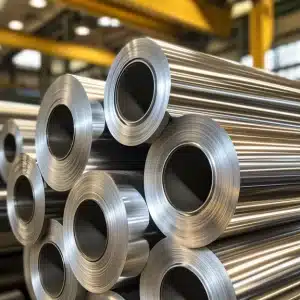
Why HAZ Hardness Profile Mapping Is Essential for Weld Integrity
Welding is a foundational process in the fabrication of pressure vessels, structural components, and mission-critical infrastructure. While it serves to permanently join metals, it also alters the material’s microstructure—especially in the heat-affected zone (HAZ). This transitional area, located adjacent to the weld, experiences thermal cycles that can significantly change hardness and mechanical properties. That’s why HAZ hardness profile mapping is vital. By conducting HAZ hardness profile mapping, engineers can identify variations in hardness that may indicate brittleness, improper heat input, or potential failure points. Incorporating HAZ hardness profile mapping into quality control protocols helps ensure structural integrity, operational safety, and adherence to ASME and API standards. For industries where safety and durability are non-negotiable, HAZ hardness profile mapping is not just recommended—it’s essential.
Understanding the Heat-Affected Zone in Welded Components
The heat-affected zone (HAZ) is a critical region in any welded joint. It refers to the portion of the base metal that, while not melted during welding, has been exposed to elevated temperatures significant enough to alter its microstructure and mechanical properties. This zone sits between the fully fused weld metal and the untouched base material. Due to rapid thermal cycling—intense heating followed by cooling—HAZ undergoes substantial changes in strength, ductility, and most importantly, hardness.
Because these transformations aren’t uniform across the HAZ, engineers consider HAZ hardness profile mapping a vital tool for assessing weld quality. Hardness variations depend on multiple factors, including the base material’s chemical composition, the type of welding process used, the amount of heat input, and the cooling rate. For example, in high-carbon steels, the HAZ may form brittle martensitic structures, which increases susceptibility to cracking. In contrast, other materials may experience localized softening, compromising load-bearing capacity.
These unpredictable changes make HAZ hardness profile mapping an essential part of weld inspection and post-weld analysis. By accurately mapping hardness levels across the HAZ, manufacturers and inspectors can detect problem areas early, validate heat treatment procedures, and ensure that welded components meet both safety and performance standards.
What Is Hardness Mapping and Why Is It Used?
HAZ hardness profile mapping involves the precise, systematic measurement and documentation of hardness values across welded joints—particularly through the heat-affected zone (HAZ). This mapping allows inspectors and engineers to visualize how hardness transitions from the unaffected base metal, through the thermally altered HAZ, and into the weld metal. By generating a detailed hardness profile, this process identifies zones of concern that may affect the overall integrity of the weld.
The primary purpose of HAZ hardness profile mapping is to detect variations in mechanical properties that could compromise safety or performance. Areas that show excessive hardening may point to the presence of brittle microstructures, increasing the risk of cracking or failure. Conversely, regions of softening may indicate insufficient strength or improper post-weld heat treatment. By evaluating these fluctuations, inspectors gain insights into how the welding process has altered the material and whether the joint meets applicable design codes and safety standards.
In critical applications such as pressure vessel fabrication, power generation, oil and gas infrastructure, and structural steel construction, HAZ hardness profile mapping is not just recommended—it’s often mandated by industry codes like ASME and API. These sectors demand high performance under extreme conditions, making it essential to verify that all welded connections will perform reliably over time.
Ultimately, HAZ hardness profile mapping serves as a cornerstone of quality assurance. It confirms that welding operations are performed correctly, that heat-affected zones remain within acceptable hardness ranges, and that the final assembly is ready for safe, long-term service in challenging environments.
Hardness Mapping Procedure in the HAZ
Test Area Selection
Before testing begins, it’s essential to properly define the zones of interest. This includes the base metal, weld metal, and the heat-affected zone. Mapping should occur along the weld cross-section, perpendicular to the weld centerline, so that a clear profile of hardness distribution can be developed. This approach captures subtle gradients that a single-point test might miss.
Testing Techniques
Several standardized methods can be used for hardness testing:
- Vickers Hardness Test (HV): Preferred for microhardness mapping due to its precision and ability to test small zones.
- Rockwell and Brinell Tests: More commonly used for macrohardness testing in larger areas or thicker materials.
For HAZ applications, microhardness testing is often the method of choice, especially when dealing with thin sections or precise mapping. Indentations are made at regular intervals, often as small as 0.5 mm apart, to ensure accuracy and resolution in the data.
Data Analysis and Interpretation
Once testing is complete, engineers plot the values on a graph or map to show hardness variations across the weld joint. A gradual change is typically expected; however, abrupt spikes or drops in hardness can indicate issues like overheating, improper heat treatment, or filler metal mismatches.
Understanding these variations helps engineers assess compliance with applicable codes and determine whether further inspection or repair is needed. Engineers define acceptable hardness limits in welding codes and project specifications.
Industry Standards and Compliance in Hardness Mapping
Hardness testing and mapping aren’t just best practices—they’re often mandated by industry standards. Common codes include:
- ASME Section IX
- AWS D1.1
- ASTM E384 for microhardness testing procedures
To maintain compliance, engineers use calibrated equipment and ensure that qualified technicians perform the tests. At Red River, engineers prioritize reliability by adhering to these standards, conducting regular equipment verification, and training technicians to the highest industry benchmarks. They document and review every test as part of a robust quality control program.
Why Hardness Mapping in the HAZ Matters
In welded structures, the heat-affected zone (HAZ) can be a hidden weak spot that affects the component’s strength and reliability. HAZ hardness profile mapping provides critical insight into how welding impacts the material’s properties. By measuring hardness throughout the HAZ, engineers can assess if thermal cycling has compromised its mechanical integrity.
Changes in the HAZ hardness—such as excessive hardening or softening—can weaken strength, ductility, and fatigue resistance. This mapping helps identify potential flaws before the component is in use.
For companies like Red River, HAZ hardness profile mapping ensures not only compliance but also the creation of durable, reliable products that meet industry standards. This approach builds trust, focusing on superior quality and safety. By integrating this mapping, manufacturers can guarantee their welded components perform safely and reliably in demanding conditions.
Need a reliable partner?
Red River specializes in the design and manufacturing of pressure vessels. We also fabricate related items such as prefabricated spools and skid packages.
Reach out to us today and experience the Red River difference. Where American-made products and American Values come together, we care more.
Frequently Asked Questions
1. Why does the HAZ show different hardness than the base metal?
The Heat-Affected Zone (HAZ) undergoes rapid thermal cycling during welding, which alters its microstructure and, consequently, its mechanical properties such as hardness.
2. What does high hardness in the HAZ indicate?
High hardness in the HAZ may indicate increased brittleness, which can raise concerns about crack susceptibility and overall weld integrity.
3. How often is hardness mapping required for pressure vessels?
The frequency of hardness mapping depends on the project code requirements and client specifications. It is typically required in critical joints or after post-weld heat treatment (PWHT).
4. What hardness test is best for HAZ mapping?
Microhardness tests, such as the Vickers method, are commonly used for HAZ mapping due to their accuracy in small and localized heat-affected zones.
5. Can hardness mapping identify weld defects?
Indirectly—unusual hardness profiles can signal potential weld issues such as overheating, improper filler metal, or lack of fusion.
6. How does Red River ensure consistent results?
Red River ensures accuracy by using certified technicians, regularly calibrated instruments, and adhering strictly to applicable codes and quality procedures.
Key Takeaways
- Hardness mapping across the HAZ is a vital diagnostic tool in welding inspection.
- It provides insight into how the weld process has altered mechanical properties like strength and ductility.
- Precision testing, correct technique, and adherence to industry standards are key for meaningful results.
Red River’s team delivers high-quality, code-compliant welds backed by thorough hardness mapping and inspection protocols.
Related Blog Post

Marine-Grade vs Standard Stainless Steel

Pros and Cons of Vertical Integration

How to Dry Desiccant Properly and Regain Its Effectiveness

Why Do Gas Turbines Need Fuel Water Separator Vessels, Red River

How Does a Gas Turbine Fuel Water Separator Vessel Work
- Vessel Weld Radiographic Inspection Procedures
- Magnetic Testing Pressure Vessels: Ensuring Structural Integrity
- Statistical Process Control Welding in Manufacturing
- Acoustic Emission Monitoring During Pressure Tests
- Phased-Array Ultrasonic Testing for Weld Inspection
- Dye Penetrant Inspection (DPI) for Surface Crack Detection
